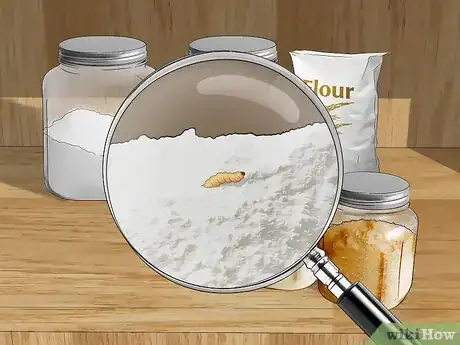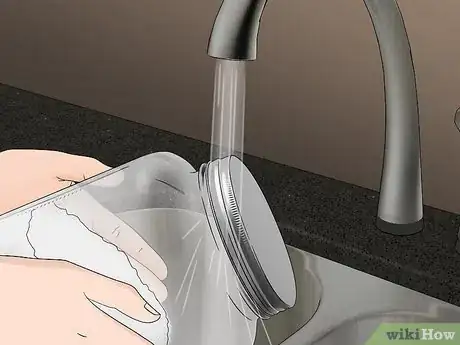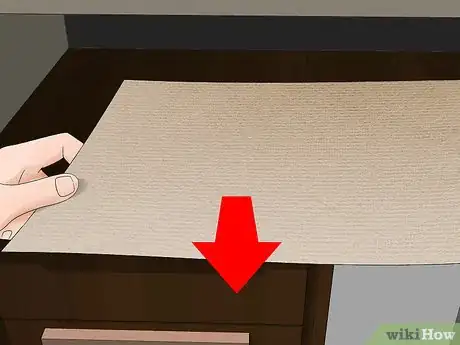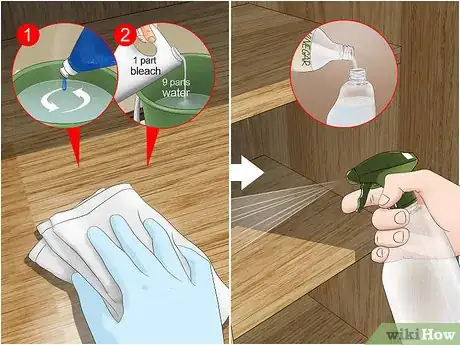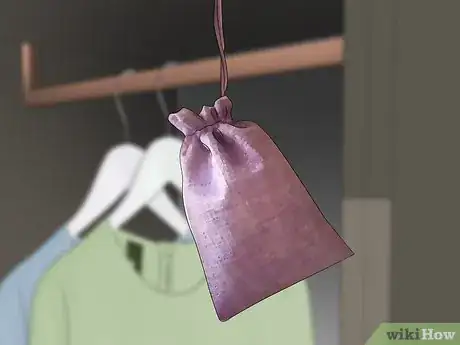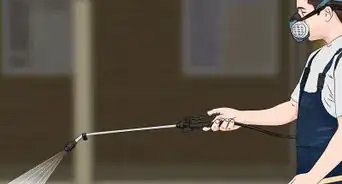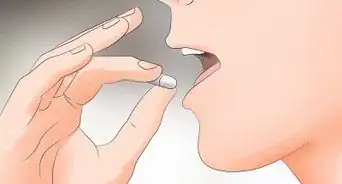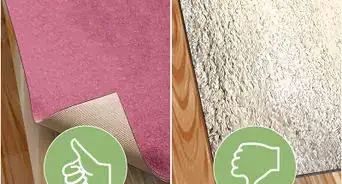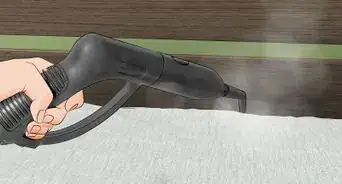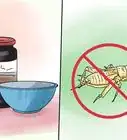This article was co-authored by wikiHow staff writer, Danielle Blinka, MA, MPA. Danielle Blinka is a Writer, Editor, Podcaster, Improv Performer, and Artist currently living in Houston, TX. She also has experience teaching English and writing to others. Danielle holds a Bachelor of Arts in English, Bachelor of Arts in Political Science, Master of Arts in English with a concentration in writing, and Master of Public Administration from Lamar University.
wikiHow marks an article as reader-approved once it receives enough positive feedback. In this case, 91% of readers who voted found the article helpful, earning it our reader-approved status.
This article has been viewed 446,702 times.
Learn more...
Moth worms are the larvae stage of a moth, which occurs just after moth eggs hatch. Moths like to lay their eggs near clothing and food pantries because these places offer lots of food options for the larvae to munch on once they hatch. If you’ve found moth worms in your clothing or kitchen, then you know the damage their munching can cause. Fortunately, you can get rid of moth worms by cleaning out your closets and wardrobes, dealing with pantry moth worms, and repelling moths.
Steps
Cleaning Your Closets or Wardrobes
-
1Remove the items. Take everything out of your closet, including non-clothing items like shoes and storage items. You will need to clean everything, so if you have things like shoe storage racks or organizational items, remove those as well to enable you to thoroughly scrub them.[1]
-
2Vacuum out the closet or wardrobe. Use an attachment or a handheld vacuum to clean the floor, walls, shelves, and ceiling of your closet. As soon as you finish vacuuming, empty the contents into a sealed bag. Remove it from the house immediately.[2]
- Make sure that you get the corners and ceiling of your closets.[3]
Advertisement -
3Wash walls and shelves. Pour soap or detergent into a bowl or bucket, then fill it with water. Stir the water to mix in the soap. Dip a clean cloth into the soapy water and use it to wipe down the walls and shelves. Continue to dip the rag into the water as you clean the entire closet.[4]
-
4Wash your clothes and other fabric items. Set your washer on the hottest cycle because the larvae can’t withstand the heat. The water should reach about 120 degrees Fahrenheit (48 degrees Celsius) in order to be fully effective. Allow the clothes to cycle for 20 to 30 minutes to ensure that all the moth worms and eggs have been killed.[5]
- Dry cleaning will also kill the larvae.
-
5Freeze items that you can’t wash. Larvae can’t survive freezing temperatures, so the freezer makes a great pesticide. Place your items in a protective covering, such as a plastic bag. Put them in the freezer, allowing at least 48 hours for the cold to kill any larvae on the item.[6]
-
6Avoid putting worn clothes into your closet. If you plan to wear clothing more than once, find another location to store it until you are ready for your second or third wear. Moths prefer clothes that have sweat or food on them, so they act as a moth magnet.[7]
-
7Store clothing in airtight containers. Keep the moths from laying new eggs by keeping clothes that you don’t wear frequently in airtight containers.[8]
- Easy to use options include sealed storage boxes, vacuum-sealed bags, and plastic storage bags.
- For added protection, apply packing tape over the seals.
Dealing with Pantry Moth Worms
-
1Look for the signs of an infestation. Look for tiny worms that look like wiggling rice, along with webbing in either food containers or the pantry. You should also notice cast off skins. Check your corners and in the dark areas of pantries for moth worms and cocoons.[9]
- The worms will grow to about ⅔-inch size (1.7 centimeters), and they have a black or brown head.
-
2Check foods to see if they’re infested. Kitchen moth worms enter your home inside food. After you bring home an item that contains moth eggs or larvae, the moth worms quickly spread to other foods. Go through your pantry, checking items for signs of infestation. You may notice the moth worms, egg casings, or webbing.[10]
- Foods that the meal moths prefer include cereals, flour, grains, birdseed, dried fruit, candy, pet food, dried herbs, nuts, and powdered milk.
- Even if you don’t see any moth worms or casings, webbing means that the food is infested.
-
3Seal items in a bag and remove them from your home. Moth worms cannot penetrate the seal of a plastic bag, so you can prevent them from spreading by putting the infested food in bags. Throw away the items as soon as possible. Don’t allow the infested foods to sit around since it’s possible that you may not have properly closed all of the seals.[11]
-
4Sort your remaining food. Unfortunately, most of your food will need to be thrown away. Any food that the moths would normally eat, such as grains or cereals, should be thrown away. If you have any food that is in a container that you cannot wash, then you will need to throw that food out as well.[12]
-
5Wash all items you plan to return to the pantry. The moths like to lay eggs in the crevices of items, so you may still have active eggs on your items. To avoid a reinfestation, wash these items well in warm, soapy water.[13]
- Check crevices such as jar lids or flaps on items wrapped in plastic.
- You can also kill moth eggs and larvae that may be on the food by putting the food in the freezer, microwaving it for 5 minutes, or baking it at 140 degrees Fahrenheit (60 degrees Celsius).[14]
-
6Replace your shelf liners. If you have any shelf liners, then you will need to remove them and throw them away, as they can harbor eggs or larvae. If you plan to place new pantry liners, wait until your infestation is completely gone before putting them down. Otherwise, you may have to replace them again if the moth worms come back.[15]
-
7Vacuum out your cupboards. Use a hose extension on your vacuum cleaner to vacuum out any visible moth worms and crumbs. Vacuum in the crevices and corners, if possible, because tiny worms and eggs tend to hide in the darkest spots.
-
8Wash your pantry shelves and walls. First wipe down all surfaces, including the pantry walls and ceilings, with a soapy rag. Follow with a mild bleach solution. You can either make your own or purchase a cleaning product that contains bleach. Afterwards, spray the shelves with plain white vinegar and wipe everything down.[16]
- To mix your own bleach solution, add 1 part bleach to 9 parts water.[17]
- Don’t forget to scrub down the corners well.
-
9Clean out your food containers. Run the containers in a hot dishwasher if you have one. If not, wash them out thoroughly by scrubbing them in a bath of hot soapy water. Finish by applying a vinegar rinse. You need to follow these extra precautions because a single moth worm hiding in one container could re-infest the entire area.
-
10Use airtight containers. Prevent a reinfestation and the contamination of new foods by storing your food in airtight containers.
- When you buy grains, flours, or meals, you may want to store them in the freezer for a week to kill off any eggs that may already exist on or in the product.
- You can also refrigerate items until you use them.[18]
Repelling Moths
-
1Use anti-moth paper or strips. You can purchase anti-moth paper or paper strips that can be placed in your wardrobe, drawers, boxes, garment bags, or pantry. This paper will kill the larvae and the moths.[19]
-
2Place cedar balls anywhere you store clothing. Cedar balls are a great natural replacement for pesticides. Cedar contains an oil that kills small moth worms, but they don’t have much of an effect on larger worms or adult moths. Hanging a cedar ball in your closet or laying one in your dresser drawer can help, though it won’t solve all of your problems.[20]
- You can also use cedar hangers.[21]
-
3Use mothballs. To be effective and safe, your mothballs should only be used when you’re storing your clothes in an airtight container. Place the mothballs in with the clothing, then seal it off. Mothballs do not work immediately, but they contain chemicals whose vapors can build up and kill moths in all stages of their life cycle.[22]
- Wear gloves while handling mothballs because they can be toxic.
-
4Add bay leaves to kitchen cabinets. Moths naturally avoid bay leaves, which you may keep in your kitchen already. For an easy and safe moth repellant, lay out a few bay leaves in your cabinets and pantries.[23]
-
5Make your own herb sachets. Moths tend to avoid the smell of lavender, peppermint, cloves, thyme, and rosemary. Place your dried herbs in a breathable bag, and then add it to your closets, drawers, and storage areas. The scent of the herbs will ward off the bugs.[24]
- You can use one herb or a combination of herbs in your sachets.
Community Q&A
-
QuestionCan moth larvae hatch out of new carpet?
 Community AnswerYes, if the carpet was already infested prior to delivery and installation, this is a definite possibility.
Community AnswerYes, if the carpet was already infested prior to delivery and installation, this is a definite possibility. -
QuestionWhat can I do if they are on my ceilings around lights?
 Community AnswerUse the end of a broom handle, stab them and flush them in the toilet.
Community AnswerUse the end of a broom handle, stab them and flush them in the toilet. -
QuestionWill the cedar balls/hangers work on an exposed clothes rail?
 Community AnswerThey should, but personally I have not found this method to be successful.
Community AnswerThey should, but personally I have not found this method to be successful.
Warnings
- Avoid using chemical moth sprays in areas with food. These chemicals are often hazardous to people as well as moth worms.⧼thumbs_response⧽
- While cedar can help with a moth infestation, it’s only useful when the scent is strong. Use multiple cedar balls and refresh them often.[28]⧼thumbs_response⧽
- It can take up to 6 months to get rid of a severe moth infestation.[29]⧼thumbs_response⧽
References
- ↑ http://www.vogue.co.uk/article/how-to-get-rid-of-clothes-moths
- ↑ http://www.vogue.co.uk/article/how-to-get-rid-of-clothes-moths
- ↑ http://www.nytimes.com/2010/01/28/garden/28fix.html
- ↑ http://www.vogue.co.uk/article/how-to-get-rid-of-clothes-moths
- ↑ http://www.nytimes.com/2010/01/28/garden/28fix.html
- ↑ http://www.vogue.co.uk/article/how-to-get-rid-of-clothes-moths
- ↑ http://www.vogue.co.uk/article/how-to-get-rid-of-clothes-moths
- ↑ http://www.nytimes.com/2010/01/28/garden/28fix.html
- ↑ https://www.todayshomeowner.com/how-to-get-rid-of-pantry-moths-and-larvae-in-your-kitchen/
- ↑ https://www.todayshomeowner.com/how-to-get-rid-of-pantry-moths-and-larvae-in-your-kitchen/
- ↑ https://www.todayshomeowner.com/how-to-get-rid-of-pantry-moths-and-larvae-in-your-kitchen/
- ↑ https://www.todayshomeowner.com/how-to-get-rid-of-pantry-moths-and-larvae-in-your-kitchen/
- ↑ https://www.todayshomeowner.com/how-to-get-rid-of-pantry-moths-and-larvae-in-your-kitchen/
- ↑ https://www.todayshomeowner.com/how-to-get-rid-of-pantry-moths-and-larvae-in-your-kitchen/
- ↑ https://www.todayshomeowner.com/how-to-get-rid-of-pantry-moths-and-larvae-in-your-kitchen/
- ↑ https://www.todayshomeowner.com/how-to-get-rid-of-pantry-moths-and-larvae-in-your-kitchen/
- ↑ https://www.verywell.com/make-your-own-disinfectant-solution-998274
- ↑ https://www.todayshomeowner.com/how-to-get-rid-of-pantry-moths-and-larvae-in-your-kitchen/
- ↑ http://www.vogue.co.uk/article/how-to-get-rid-of-clothes-moths
- ↑ http://www.nytimes.com/2010/01/28/garden/28fix.html
- ↑ http://www.vogue.co.uk/article/how-to-get-rid-of-clothes-moths
- ↑ http://www.nytimes.com/2010/01/28/garden/28fix.html
- ↑ https://www.todayshomeowner.com/how-to-get-rid-of-pantry-moths-and-larvae-in-your-kitchen/
- ↑ https://www.thebalance.com/get-rid-of-moths-1388158
- ↑ http://www.nytimes.com/2010/01/28/garden/28fix.html
- ↑ http://www.vogue.co.uk/article/how-to-get-rid-of-clothes-moths
- ↑ http://www.nytimes.com/2010/01/28/garden/28fix.html
- ↑ http://www.nytimes.com/2010/01/28/garden/28fix.html
- ↑ https://www.todayshomeowner.com/how-to-get-rid-of-pantry-moths-and-larvae-in-your-kitchen/
About This Article
To get rid of moth worms in your closet, remove everything form your closet and vacuum all of the surfaces, including the walls, floor, and shelves. Be sure to empty the vacuum into a resealable bag as soon as you finish vacuuming. Then, wash the walls and shelves with soap and water, and let them air dry. As the closet is drying, wash all of the clothes that were in the closet, and place any other items that can't be washed, like stuffed animals, in the freezer to kill the larvae. For tips on storing your clothes and dealing with pantry moths, read on!








